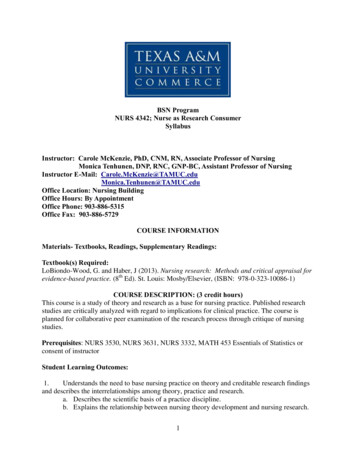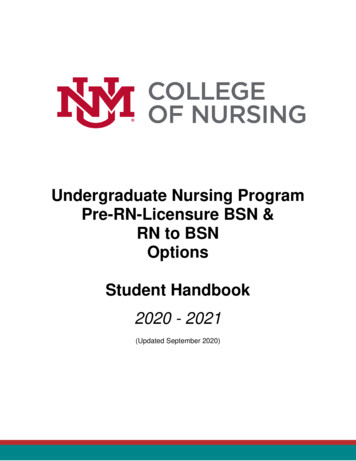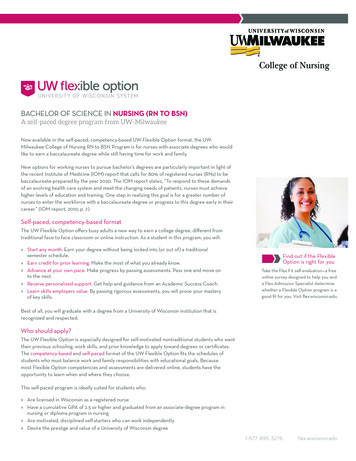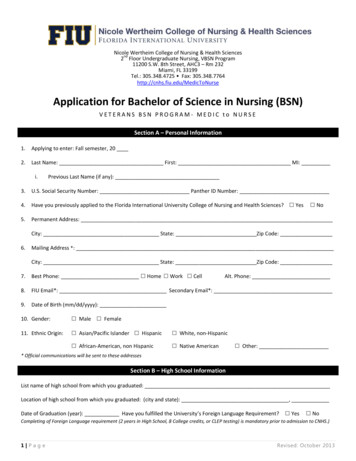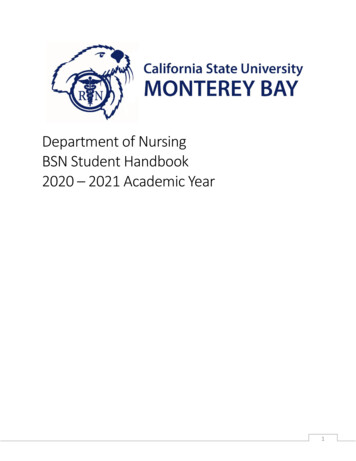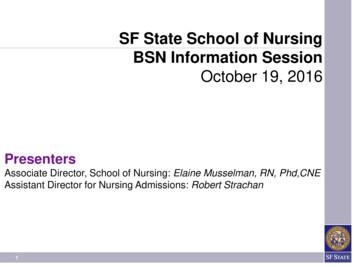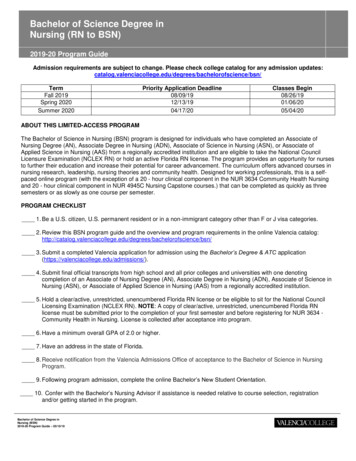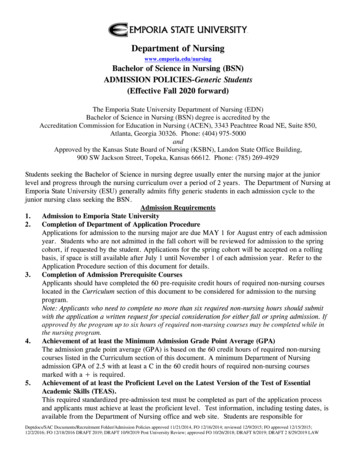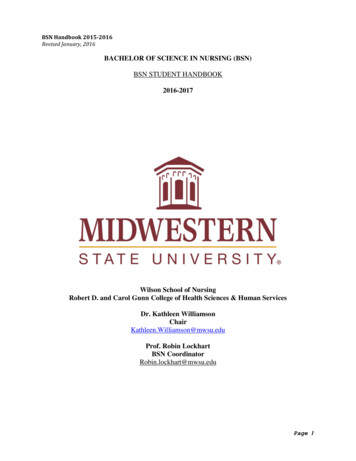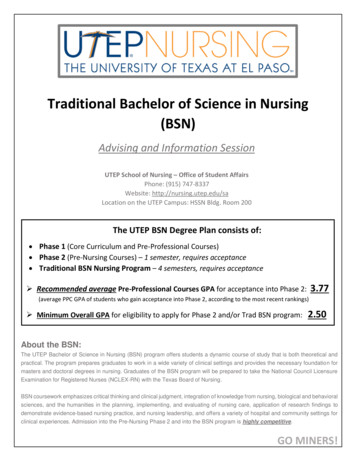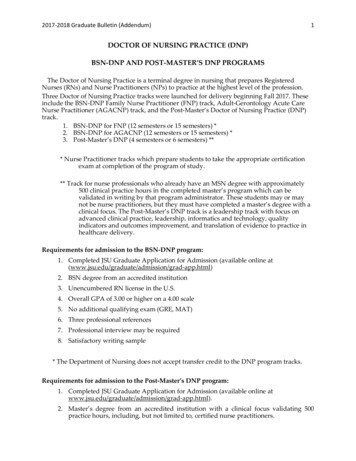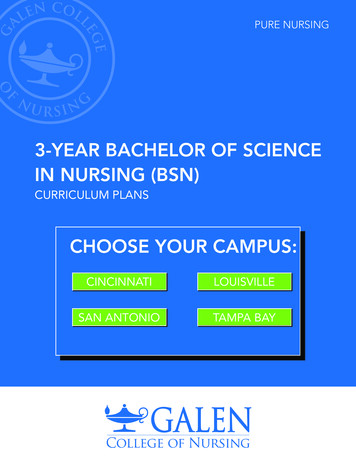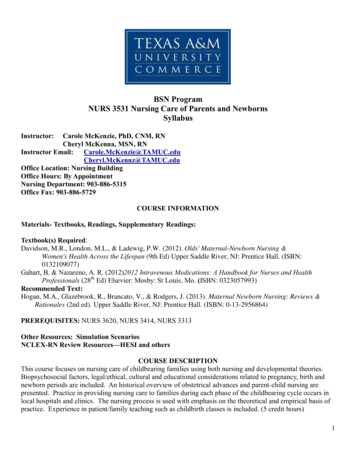
Transcription
BSN ProgramNURS 3531 Nursing Care of Parents and NewbornsSyllabusInstructor:Carole McKenzie, PhD, CNM, RNCheryl McKenna, MSN, RNInstructor Email: ffice Location: Nursing BuildingOffice Hours: By AppointmentNursing Department: 903-886-5315Office Fax: 903-886-5729COURSE INFORMATIONMaterials- Textbooks, Readings, Supplementary Readings:Textbook(s) Required:Davidson, M.R., London, M.L., & Ladewig, P.W. (2012). Olds' Maternal-Newborn Nursing &Women's Health Across the Lifespan (9th Ed) Upper Saddle River, NJ: Prentice Hall. (ISBN:0132109077)Gahart, B. & Nazareno, A. R. (2012)2012 Intravenous Medications: A Handbook for Nurses and HealthProfessionals (28th Ed) Elsevier: Mosby: St Louis, Mo. (ISBN: 0323057993)Recommended Text:Hogan, M.A., Glazebrook, R., Brancato, V., & Rodgers, J. (2013). Maternal Newborn Nursing: Reviews &Rationales (2nd ed). Upper Saddle River, NJ: Prentice Hall. (ISBN: 0-13-2956864)PREREQUISITES: NURS 3620, NURS 3414, NURS 3313Other Resources: Simulation ScenariosNCLEX-RN Review Resources—HESI and othersCOURSE DESCRIPTIONThis course focuses on nursing care of childbearing families using both nursing and developmental theories.Biopsychosocial factors, legal/ethical, cultural and educational considerations related to pregnancy, birth andnewborn periods are included. An historical overview of obstetrical advances and parent-child nursing arepresented. Practice in providing nursing care to families during each phase of the childbearing cycle occurs inlocal hospitals and clinics. The nursing process is used with emphasis on the theoretical and empirical basis ofpractice. Experience in patient/family teaching such as childbirth classes is included. (5 credit hours)1
Student Learning Outcomes:At the completion of the course, the student will be able to:1.Define legal, cultural, ethical, economic, historical, and political factors which impact the delivery offamily centered health care.2.Describe normal and abnormal physiological and psychological changes that occur during each periodof the childbearing cycle and newborn period.3.Discuss the role of the nurse that reflects an understanding of the legal and ethical issues that impact thechildbearing family.4.Use relevant evidence based practice for decision making in relation to childbearing families and thenewborn.5.Synthesize theories and concepts from liberal education to build an understanding of the humanexperience.6.Discuss the role of the nurse and the use of nursing standards to monitor patient/family care.7.Prepare a teaching plan based on principles of teaching/learning.8.Discuss caring in relation to nursing the childbearing family and newborn.9.Demonstrate responsibility for growth and development as a learner and a professional.10.Apply theory related to computer-human interfaces, ethics, confidentiality and privacy, ergonomics andnursing informatics to nursing practice.Clinical Objectives:At the completion of the clinical rotation, the student will be able to:1.Use evidence based information to formulate and modify the nursing plan of care.2.Derive nursing diagnoses from physiological, psychological, social, and cultural data gathered from avariety of sources.3.Use the nursing process to plan holistic nursing care for the childbearing family.4.Demonstrate effective communication with individuals and families to promote optimum well-being.5.Utilize the nursing process and safety principles in the care of all clients.6.Implement a teaching plan using principles of nutrition for the antepartum patient and/or thebreastfeeding patient.7.Demonstrate collaborative skills with members of the interdisciplinary health care team in planning,coordinating, providing and evaluating patient care of the childbearing client.8.Perform safe nursing interventions that reflect caring behaviors in response to physical, emotional,cultural, and humanistic care needs.9.Demonstrate professionalism, including accountability, attention to appearance, demeanor, respect forself and others, and attention to professional boundaries with patients and families as well as amongcaregivers.10.Develop patient teaching that reflects developmental stage, age, culture, spirituality, patient preferences,and health literacy considerations to foster patient engagement in care.11.Demonstrate performance of nursing psychomotor skills in a safe manner.12.Utilize organizational skills and time management concepts in setting priorities in providing patient care13.Demonstrate critical thinking decision makings skills based on standards of practice, theory, andresearch.14.Apply ethical standards related to data security, regulatory requirements, confidentiality, and clients’right to privacy.15.Demonstrate professional standards of moral, ethical, and legal conduct.16.Evaluate client outcomes for psychobiological intervention effectiveness.17.Create a safe care environment that results in high quality patient outcomes.2
COURSE REQUIREMENTSInstructional / Methods / Activities AssessmentsThis course consists of a series of activities and assessments to assist you in achieving the outcomes/objectivesfor the course. Each week you will complete various combinations of online assignments, activities, readings,etc. Instructional Strategies that may be used include: lecture, discussion, demonstration, media resources (YouTube andothers), role playing, simulation, team-based learning strategies, audio-visual aids, computer assisted instruction, studyand practice groups, case study, clinical assignments and supervision, post clinical conferences, Critical Thinking Tool onassigned patients, practice and return demonstration in campus laboratory.GradingGrades will be determined as follows:Mynursinglab assignments5%Exam #120%Exam #220%Exam #320%Ethical Issues Paper10%Final ESI OB will be administered to students upon completion of all lecture content. Students must obtain a minimumscore of 850. Students who score above 850 will receive 1-3 points added to their final grade. The number of pointsearned is dependent upon the student’s composite score. (See policy in Student Nursing Handbook)Grading Scale:A 90-100B 80-89C 75-79D 67-74F 66 and BelowA minimum grade of 75 is required to pass the course.Satisfactory completion of the clinical component requires the following:1.Completion of the following assigned activities PRIOR to start of clinical:Nursing Assessment of the Intrapartum PatientNursing Assessment of the Postpartum PatientPhysical Assessment of the NewbornGestational Age Assessment of the Newborn (video)2.Demonstration of postpartum and newborn assessment skills. Students will NOT be allowed in clinical untilthis has been achieved.3.Newborn assessment and care plan.4.Gestational Age Assessment of the Newborn5.Post-partum assessment and care plan.6.Intrapartum patient assessment and care plan.7.Teaching plan in the postpartum patient (may be maternal or newborn related). Due on the 2nd Postpartumclinical experience.8.Reflective clinical journals for each clinical experience utilizing the reflective journal template.9.Maintain clinical log of clients’ age, diagnosis, sex (newborn).3
Each student is expected to submit care plans and assignments at designated times. Designated times will bedetermined by each clinical instructor.TECHNOLOGY REQUIREMENTSThe following information has been provided to assist you in preparing to use technology successfully in thiscourse.-Internet access/connection-high speed recommended (not dial up)-Word Processor (MS Word, or Word Perfect)Additionally, the following hardware and software are necessary to use eCollege:Our campus is optimized to work in a Microsoft Windows environment. This means our courses work best ifyou are using a Windows operating system (XP, Vista, or 7) and a recent version of Microsoft Internet Explorer(6.0, 7.0, 8.0, or 9.0).Your courses will also work with Macintosh OS X or better along with a recent version of Safari (5.1 is nowavailable). Along with Internet Explorer and Safari, eCollege also supports the Firefox browser (3.0) on bothWindows, and Mac operating systems.It is strongly recommended that you perform a “Browser Test” prior to the start of your course. To launch abrowser test, login to eCollege, click on the “myCourses” tab, and then select the “Browser Test” link underSupport Services.COMMUNICATION AND SUPPORTCommunication between faculty and students is important and taken seriously. Preferred communicationmethods are through individualized faculty office hours, email, or office phone. If a phone call is not answered,please leave a message and send an e-mail using the direct e-mail link on the course home page. You will betreated with collegial respect and you are expected to communicate likewise in a professional manner.COURSE AND UNIVERSITY PROCEDURES/POLICIESCLASS1.Class Cancellation: In the event that a class is canceled, the student is expected to do the readings and completethe objectives for that day. The content will still be included on examinations. The material in this syllabus anddates identified in the Course Calendar are subject to change.2.Class attendance is expected. The students should notify course faculty in advance of any absence.3.Exam dates are listed in each course syllabus, and the student is expected to be present for exams. In the eventthat the student will be absent, the course instructor must be notified in advance. Failure to do so will result in thestudent receiving a zero for the missed exam.4.As an adult learner and responsible professional, the student is responsible for reading and completingassignments prior to class and for being prepared to participate in discussions over the assigned material. It shouldnot be expected that all material will be covered in class. Students are expected to come to class prepared.5.Assignments must be handed in on time. Assignments submitted late without prior arrangement with theclassroom instructor will receive a zero.NURSING SKILLS LABORATORY1.Students are responsible for assigned readings in textbooks and completing DVD and other assignments prior tolab. Participation in discussions over the assigned material is expected. Failure to prepare will result in an4
2.unsatisfactory for the lab session. All lab sessions must be completed satisfactorily to progress to the clinicalsetting.Students must adhere to the clinical dress code for skills laboratory sessions. Refer to the Nursing Student Guidefor policy information.CLINICAL EXPERIENCE1.Clinical attendance is mandatory. Refer to the Nursing Student Guide for absence policy information.2.Immunizations, CPR, and TB status must be current for students to be able to attend clinical experience at theassigned clinical location.3.Students will be allowed to perform designated nursing skills in the clinical setting only after receiving instructionand successfully demonstrating the skill in the Nursing Skills Laboratory.4.Students are expected to meet clinical expectations outlined in the clinical evaluation tool.5.Based on student learning needs, the faculty will determine the appropriate amount of time and clinicalassignments needed to assess student growth. Faculty may require additional assignments and clinical work toensure students have met clinical objectives. Students are expected to comply with any additional assignments orclinical hours assigned.6.Students are expected to prepare for clinical practice in order to provide safe, competent care.7.Clinical assignments must be handed in on time to the clinical instructor. No exceptions. Clinical paperwork isdue Thursdays by 5pm on the student’s clinical week.8.Clinical is graded Pass/Fail. If the student fails the clinical component, the entire course must be repeated.UNSATISFACTORY CLINICAL PERFORMANCE1.There are several infractions that might lead to a student being given a clinical warning for the day, including butnot limited to:AbsencesTardinessViolation of dress codeIncomplete health immunization recordsExpired CPR certificationFailure to turn in written assignments on timeIncomplete hospital orientationLack of preparation2.Accumulation of two (2) warnings in this clinical course will lead to failure of the clinical rotation and therefore,failure of the entire course.3.Other offenses which may lead to immediate failure of the course include but are not limited to:A pattern of lack of accountability for class, clinical and lab skills preparationUnsafe or unprofessional practices or behaviorsHIPPA violationsInability to pass required clinical assignmentsFalsification of recordsInability to achieve 90% on the dosage calculation examStudents with Disabilities:The Americans with Disabilities Act (ADA) is a federal anti-discrimination statute that provides comprehensivecivil rights protection for persons with disabilities. Among other things, this legislation requires that all studentswith disabilities be guaranteed a learning environment that provides for reasonable accommodation of theirdisabilities. If you have a disability requiring an accommodation, please contact:Office of Student Disability Resources and ServicesTexas A&M University-CommerceGee Library5
Room 132Phone (903) 886-5150 or (903) 886-5835Fax (903) 468-8148StudentDisabilityServices@tamuc.eduStudent Conduct Code – Refer to the BSN Student GuideStudents must adhere to standards of professional and academic conduct. Academic misconduct involves anyactivity that tends to compromise the academic integrity of the University, or subvert the educational process,including, but not limited to, cheating, plagiarism, falsifying academic records, misrepresenting facts and anyact designed to give unfair academic advantage to the student or the attempt to commit such an act. Students areresponsible for their own academic honesty and for reporting violations of academic honesty by others.Week12COURSE OUTLINEContentContemporary Maternal-Newborn Nursing; Assessment ofIntrapartum, Newborn, and Postpartum Clients13Human Reproduction; Physiologic/Psychologic Changes ofPregnancy; Antepartum Nursing Assessment; Needs and Care of theExpectant Family ; Adolescent Pregnancy and Maternal NutritionPregnancy at Risk, Pregestational and Gestational Problems andAssessment of Fetal Well-BeingProcesses/Stages of Labor; Intrapartum Nursing Assessment;Family in Childbirth: Needs and Care; Pain Management duringLaborChildbirth at Risk—Pre-Labor and Labor Related Complications;Birth ‘Related ProceduresPostPartum Family Adaptation; Needs and Care; Home Care;PostPartum Family at Risk; Grief and LossPhysiologic Responses of the Newborn to Birth; Nursing Assessmentof the NewbornThe Normal Newborn: Needs and Care; Newborn NutritionNewborn at Risk: Conditions Present at Birth/Birth Related StressorsWomen’s Health Issues14HESI Exam3 &45&67&89&1011&12Reading AssignmentOlds,Unit IChapters 22-23and Kozier and Erb, pp.458-460Olds, Units 3 and 4 Chapters 29, 30, and 35Olds,Chapters 19-21Olds,Chapters 22-25Olds,Chapters 26-28Olds, Unit 7Olds,Unit 6Olds, Unit 2All Assigned Chapters andReview Book15Review for FinalAll Assigned Chapters andReview Book16Comprehensive FinalAll Assigned ChaptersIn addition, review chapters for exam are on the required reading list. In addition, reading appropriate toclinical assignments are expected and will be assessed in the clinical area by individual instructors.6
Student:Topic:NURS 3531Teaching/Learning PlanGrading RubricDate:PointsEarnedCommentsPlanning (4 points each)1. Factors affecting learning are addressed.2. Learner(s) need(s) is/are evident in description3. Readiness of patient(s) to learn is summarized4. Management of the learning environment is described5. Visual aids are appropriate to the patient(s) and setting6. Teaching strategies and materials are identifiedContent (10 points each)7. Nursing Diagnosis is appropriate to client’s learning needs andis correctly stated8. Outcomes address the 3 domains of learning (cognitive,affective, psychomotor)9. Outcomes are specific, realistic, and measurable10. Interventions address learning needs11. Content is described with adequate detail with scientificrationales included12. Evaluation of teaching and patient learning are evident in theplan13. Statement to discontinue, modify, or continue plan is includedFormat (3 points each)14. References are in APA format15. Teaching plan is prepared in proper from, correct spelling andfree of errors.NURS 35317
Ethical IssuesGrading RubricContent1. Describes the dilemma in detail having gathered pertinentfacts.COMMENTS:2. The issues pros and cons are thoroughly discussed.COMMENTS:3. Determines who should be involved in the decision makingprocess and thoroughly reflects on the viewpoints of allinvolved.COMMENTS:4. Identifies a number of alternatives and in detail evaluateseach on the basis of whether or not there is interest andconcern over the welfare of all involvedCOMMENTS:5. Formulates a plan that is a thoughtful reflection on thebenefits and risks of actionCOMMENTS:6. Discuss how these ethical issues can affect nursing as awhole.COMMENTS:7. Thorough, logical and clear discussion of the decision andhow it relates to one’s own philosophy of ethics.COMMENTS:8. Content is comprehensive and accurate.COMMENTS:9. Language is clear and precise; sentences display consistentlystrong, varied structure.COMMENTS:10. Structure of the paragraph is clear and easy to follow.COMMENTS:11. Paper follows designated guidelines (APA format, 12-font, 34 pages in length, excluding bibliography).COMMENTS:12. Rules of grammar, usage, and punctuation are followed;spelling is correct.COMMENTS:Total PointsPoints10Earned1010151015555555100NURS 35318
Nursing Care PlanGrading RubricContent (0-5 points per element)Assessment1. Assessment data is complete and accurate.2. Erickson’s stage is accurately identified and includessupportive data (behaviors).3. Identifies abnormal lab and diagnostic findings withexplanation for abnormal findings as it relate to patientdiagnosis.4. Medication information is complete.5. Pathophysiology Tree completed on hi-risk diagnosis.Nursing Diagnosis6. A minimum of 3 NANDA nursing diagnoses are listed.7. Includes all 3 parts (stem, related to or R/T, and asevidenced by [AEB] for actual diagnosis).8. Diagnosis is appropriate for client and includes actual andrisk diagnoses9. Nursing Diagnoses are prioritized.Planning10. Realistic short-term client goals listed.11. Goals are measureable.Implementation12. A minimum of 5 interventions (2 assessment, 2 nursing care,1 teaching).13. Dependent, collaborative, and independent nursinginterventions are identified.14. Interventions are specific and individualized to the client.15. Interventions are measurable and realistic.16. Interventions are supported by theory . Evaluated client responses to interventions.18. Evaluated short term goals as met, unmet, or partially metand reason goals were unmet or partially met.19. Stated continuation, modification, or completion of plan.References20. APA format is used on separate page (all sources used forrationales, evidence-based interventions).GradeCommentsGrade:Students must achieve a grade of 75 or better per care plan.NURS 35319
REFLECTIVE Clinical Journal TEMPLATEName:Date Submitted:Select a patient-nurse exchange related to a nursing issue.Take notes and write a narrative with 3-8 lines per sub-category topic (*).Reference: Johns, C. (2002). Guided Reflection: Advancing Practice.I. Focus attention*What was your emotional state upon arriving for clinical? (2 points)* Describe your assignment for the day. (2 points)II. Description*Selected patient situation (what was going on with your patient physiologically, psychologically): (2 points)*Were there any significant moments (positive or negative)? (2 points)III. ReflectionsPatient:*Responses to situ
nursing informatics to nursing practice. Clinical Objectives: At the completion of the clinical rotation, the student will be able to: 1. Use evidence based information to formulate and modify the nursing plan of care. 2. Derive nursing diagnoses from physiological, psychological, social,
